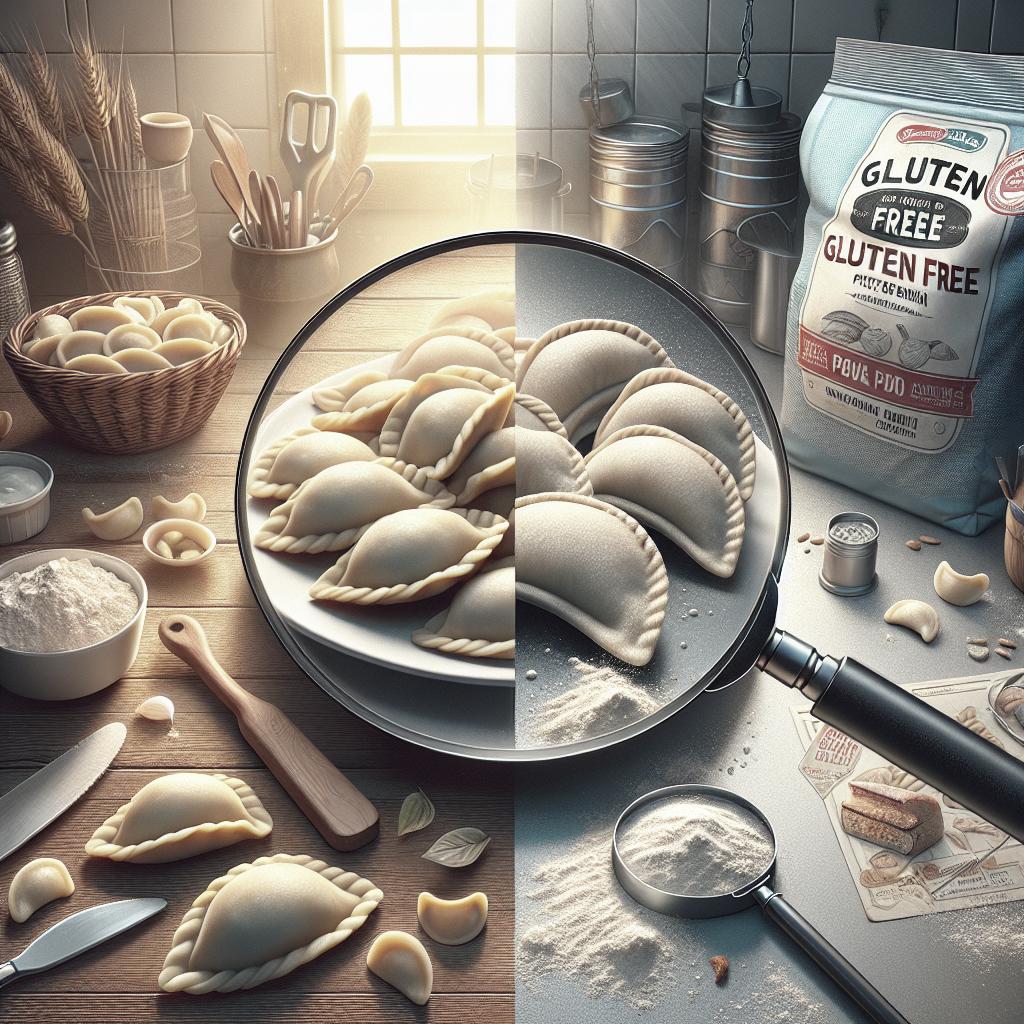Exploring Gluten-Free Pierogi and Delicious Recipes
Pierogis are a beloved comfort food that have a special place in Eastern European cuisine. Traditionally filled with potatoes, cheese, and onions, their dough usually contains gluten. This blog post will delve into the world of gluten-free pierogi, offering insights into making them deliciously at home, and explore related recipes and storage tips. From perfect gluten-free flour blends to troubleshooting and serving suggestions, each section aims to equip you with knowledge and practical skills to enhance your cooking endeavors. Whether you’re gluten intolerant or simply experimenting, this guide will inspire your culinary creativity, ensuring everyone can enjoy these delectable dumplings without dietary concerns.
Gluten-Free Lemon Bars Recipe
Before diving into the art of making gluten-free pierogi, let’s sweeten the deal with a tangy gluten-free lemon bar recipe. The classic dessert is as refreshing as it is satisfying, perfect for a light yet indulgent treat. The use of a gluten-free flour blend ensures that the base maintains its crispness while the lemon filling provides just the right balance of sweet and tart.
To create the gluten-free base, choose a flour mix that mimics the properties of wheat flour. Combine it with sugar, butter, and a pinch of salt to form a dough that’s easy to press into your baking pan. The filling, a simple mixture of fresh lemon juice, eggs, sugar, and a touch of lemon zest, should be whisked until smooth and poured over the baked base. Bake until the filling is set, and allow it to cool before slicing into squares.
About This Gluten-Free Potato Pierogi Recipe
This gluten-free potato pierogi recipe is crafted with care to ensure that gut health is prioritized without compromising on taste and texture. Unlike traditional pierogi, this version employs a carefully selected gluten-free flour blend to create a pliable dough that encapsulates the classic potato filling wonderfully.
The key to a successful gluten-free pierogi dough lies in achieving the right consistency. Our recipe utilizes ingredients that replicate the chewiness of the original dough while ensuring that it remains tender and easy to work with. Each step is described in detail to guide you through the process, offering tips and tricks to navigate common challenges faced when cooking gluten-free.
Gluten-Free Pierogi
Ingredients
Begin by gathering high-quality ingredients that enhance the flavor and texture of your pierogi. Key components include a gluten-free all-purpose flour blend, eggs, sour cream, and a touch of xanthan gum for elasticity. The filling consists of mashed potatoes, cheese, and sautéed onions, offering a comforting and hearty flavor profile.
For additional flair, consider experimenting with alternative fillings such as sautéed mushrooms, spinach, or even sweet options like fruit or chocolate. Adjust seasonings to your preference, ensuring a perfect balance that complements the texture of the gluten-free dough.
Instructions
Begin by making the dough, combining your gluten-free flour blend with the wet ingredients to form a smooth and elastic mass. Allow it to rest, covered, to enhance its workability. While the dough rests, prepare your chosen filling by mixing mashed potatoes with cheese and the browned onions.
Roll the dough out on a floured surface and use a cutter to create uniform circles. Place a spoonful of filling onto each circle, fold, and seal with a fork or your fingers. Boil the pierogi until they float, and sauté for a few minutes in butter before serving to achieve a delightful golden crust.
Notes
Accuracy in measurement is crucial when creating gluten-free recipes due to varying flour properties. Always spoon and level your dry ingredients instead of scooping directly from the bag. This ensures consistent results across multiple batches.
Feel free to adjust the dough’s thickness and filling to match your personal preferences. Gluten-free pierogi are versatile and adaptable, capable of accommodating a range of dietary needs and flavor profiles.
Ingredients For Gluten-Free Pierogi
The main components for gluten-free pierogi include gluten-free all-purpose flour, eggs, and sour cream, which together, form the base of the dough. A dash of salt enhances the flavor, while xanthan gum offers structure and pliability.
For the filling, choose starchy potatoes for a smooth mash, while cheddar or another meltable cheese adds depth and richness. Onions, either sautéed or caramelized, provide an aromatic sweetness to balance the dish.
How To Make Gluten-Free Pierogi
Creating gluten-free pierogi requires attentiveness throughout the preparation process. Start by whisking together your dry ingredients, then gradually incorporate the wet elements. Kneading depends on achieving a dough that feels slightly sticky yet cohesive.
Divide and roll the dough thinly before cutting into rounds. Fill and fold each piece with care to avoid leaks during cooking. Boil for tenderness, then finish in a skillet with butter to add a deliciously crisp exterior.
Troubleshooting: Common Questions With Gluten-Free Pierogi
One common concern is achieving the right dough consistency. If the dough feels too dry, lightly wet your hands while kneading. If it’s too sticky, gradually incorporate more flour until manageable.
Another frequent issue is ensuring the pierogi do not burst when cooking. Be mindful of overfilling and ensure a tight seal on the edges. If this continues to be a problem, consider adjusting the cooking time and temperature.
Gluten-Free Flour Testing
Not all gluten-free flours are created equal, impacting the texture and flavor of your finished pierogi. Experiment with different brands and blends to find one that produces the ideal balance of elasticity and flavor.
Some bakers prefer personal blends, combining rice flour, potato starch, and tapioca flour, among others. Test various combinations in smaller batches to find your preferred mix that delivers consistent and pleasant results.
Can I Make These Pierogi Dairy-Free?
Yes, with mindful substitutions, you can create dairy-free gluten-free pierogi. Opt for non-dairy alternatives like almond or coconut yogurt to replace sour cream and choose dairy-free cheeses for the filling.
Incorporating plant-based milk and cheese in your recipe can also offer a unique flavor twist while adhering to dietary restrictions. Check the packaging to ensure all ingredients are gluten-free as well for a cohesive dish.
Can I Buy Frozen Gluten-Free Pierogi?
Frozen gluten-free pierogi can often be found in health food or specialty stores, catering to those who need a quick option without the preparation process. Many brands offer a variety of fillings, from traditional to modern spins.
It’s essential to read labels carefully when purchasing pre-made pierogi to confirm they meet your dietary needs. For optimal quality, choose brands with positive reviews and consider trying several to find your favorite.
How Much Time Do I Need To Make Pierogi?
Preparing gluten-free pierogi from scratch requires a dedicated chunk of time due to the mixing, resting, and rolling processes. Estimate around two to three hours from start to finish when making them for the first time.
As you grow more accustomed to the steps, you’ll likely find ways to streamline the process, particularly by preparing fillings in advance and multitasking during dough rest periods.
What Can I Serve With Gluten-Free Pierogi?
Gluten-free pierogi are versatile and can be served as a main dish or a side. Pair them with sautéed vegetables, a fresh salad, or even enjoy them topped with caramelized onions and a dollop of sour cream.
They’re also delightful as part of a comfort food spread, complemented by hearty soups and stews, or served with a crisp side of pickles for a contrasting zing.
How Should I Store Pierogi?
Leftover pierogi should be stored in an airtight container and refrigerated. They generally last up to three days and can be reheated in a skillet or microwaved before serving.
Maintain their quality by ensuring they are completely cooled before storage, and consider laying them in a single layer to prevent sticking and breaking.
Can I Freeze or Make Ahead Gluten-Free Pierogi?
Gluten-free pierogi freeze well, making them an excellent make-ahead dish. Arrange them in a single layer on a tray, freeze until solid, then transfer to a freezer-safe container or bag.
Reheat frozen pierogi by boiling them directly from the freezer and sautéing as usual. This helps maintain their texture and ensures an effortless meal option down the line.
More Fall
As autumn approaches, take advantage of the season’s bounty to incorporate fresh and flavorful ingredients into your cooking realm. Explore heartier dishes that radiate warmth and comfort, perfect for chilly evenings.
From rich stews and roasts to cozy desserts speckled with cinnamon and spice, fall cooking offers endless possibilities. Let your creativity flourish as you explore these seasonal classics recreated in gluten-free form.
More Gluten-Free Recipes To Try
Expand your gluten-free repertoire with an array of diverse recipes ranging from breakfast to dessert. Experience new flavor profiles with dishes like gluten-free pancakes, crisp apple crumbles, or succulent grilled dishes.
Experiment with ethnic cuisines, adapting classics to fit your dietary requirements. These recipes invite exploration while maintaining the core essence of the meals you know and love.
| Section | Content Summary |
|---|---|
| Gluten-Free Lemon Bars Recipe | A classic dessert made with a crisp gluten-free base and a sweet-tart lemon filling. |
| About This Gluten-Free Potato Pierogi Recipe | Details on crafting gluten-free pierogi with potato filling, focusing on texture and consistency. |
| Gluten-Free Pierogi Ingredients & Instructions | Essential components and step-by-step guide for making gluten-free pierogi successfully. |
| Troubleshooting & Adaptations | Tips for common issues and how to make dairy-free or purchase frozen options. |
| Additional Gluten-Free Recipes | Exploration of other gluten-free recipes to enjoy, especially during the fall season. |


